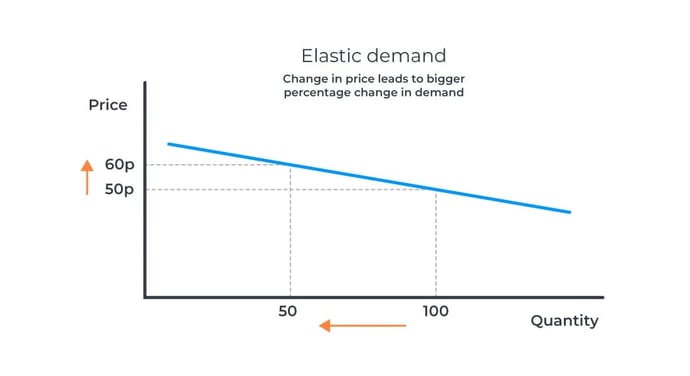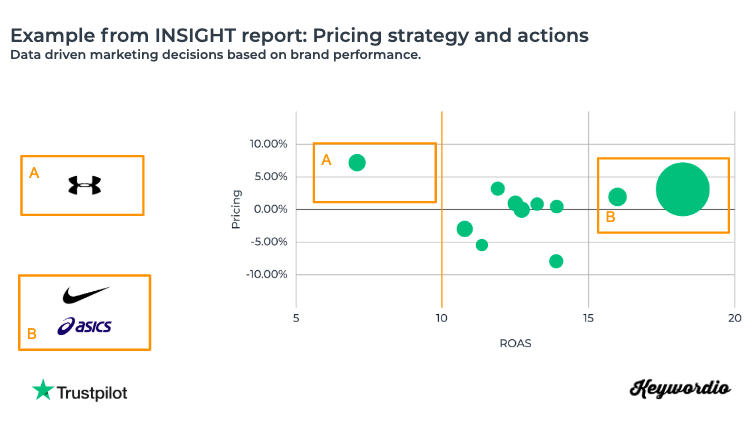

Get monthly notifications
4 Pricing Strategies Every eCommerce Business Need to Work With
No matter what line of business you’re in, competition is continuously growing more intense. Something that can prove to be quite troublesome for e-commerce is the pricing of your products. If the price is too high there’s a possibility your customers leave, and if the price is too low your profit margins can be brought down. It’s therefore important to consider different pricing tactics, how to handle your competition and continuously work to increase profit margins. To understand if pricing or management of your Google Ads channel will have the highest impact on your growth download our free benchmark study of +500 million Ads.
These are four concepts you should be well aware of when setting up pricing strategies:
- Dynamic pricing
- Price threshold
- Price sensitivity
- Price elasticity
Dynamic pricing
Dynamic pricing is one of the best ways for e-commerce to optimize prices on their products and thereby grow revenue and improve conversion rates. It’s an e-commerce strategy that implements variable pricing instead of fixed pricing.
How sales volume relates to price-ratio in light, medium and high elastic categories
%20(1)-1.jpg?width=690&height=376&name=4-pricing-strategies-every-e-commerce-business-need-to-work-with-01%20(1)%20(1)-1.jpg)
How static pricing and dynamic pricing relate to price and demand
-1.jpg?width=1100&height=600&name=4-pricing-strategies-every-e-commerce-business-need-to-work-with-02%20(1)-1.jpg)
Dynamic pricing has become an important part of e-commerce since when you don’t have physical stores you don’t need to manually change the price on thousands of items. The price of a product can quickly and easily be dynamically adjusted online. It’s becoming more important than ever to carefully make strategic marketing decisions concerning the price of your products. There are mainly two things you need to consider when it comes to dynamic pricing:
- How to tactically address dynamic pricing through advertising and promotions
- What role pricing play in a traditional marketing strategy
The dynamic pricing strategy usually works best if the system is easily understandable for the customers and suitable for their needs. Dynamic pricing can, for instance, prove valuable when used on seasonal products that vary in demand over the year. Dynamic pricing can distribute the demand over the year or just drive demand during off periods.
Another thing to be aware of is that transparency is something to value when it comes to dynamic pricing strategy. In this digital age where almost everything is searchable, customers will eventually see if dynamic pricing is intentionally hidden, and that will have a negative effect on them. It’s therefore much better to be transparent and communicate openly with consumers.
A common strategy for an e-commerce company running dynamic pricing is to adjust the prices late on Friday night. You want to make sure that the competition who’s manually adjusting prices will have the challenge to follow over the weekend.
Price threshold and price sensitivity
Two important concepts in digital marketing are price threshold and price sensitivity. Price sensitivity is usually measured by how customers react to different prices when it comes to buying products. Let’s say you have a pair of socks that cost 10 €, and a similar pair of socks that cost 8 € – then the customers will most likely go with the pair of socks for 8 €. But if the more expensive pair of socks have better quality and offers a warranty, then most customers won’t care about that extra 2 €. This is also why companies use price thresholds like 2,99 € instead of 3 €. There’s almost no difference between these prices, but if a customer is comparing the price of your product with another that is only a little bit more expensive, they might go with you.
The price threshold is the price/price point where a potential customer is becoming intrigued to buy a product. It’s a very important metric for marketers when working on their target audience price sensitivity. When a company sets a price on a product, it’s set at a specific price point which is achieved through market research and competition analysis. Customers find this price point acceptable, and they will either buy the product or go for what seems to be the best alternative. You could define it as the threshold where customers feel most comfortable to make a purchase.
How to increase the price of a product without loss in customers?
- Customize your product - add more features to make customers feel that the price change is worthwhile. A new, higher price is justified if the new product is better than its predecessor, right? In Google Ads, this is done by experimenting with Ad Copy, customer reviews and product reviews for both search ads and Google Shopping
- Offer discounts - If you initially launch a special promotion or discount offer, customers are much more likely to accept a subsequent price boost. Track and monitor price sensitivity in a data-driven way. In Google Ads, you could, for example, run experiments for products from an important brand.
- Raise prices gradually - the most effective way to adjust your prices is to raise them slowly. This will, of course, vary depending on the product, but one idea is to gradually increase the price each quarter. Remember to monitor how the price change affects the ROAS in Google Ads (Return on Ads spend)
Price elasticity
This is a term for how large the demand is for a specific product or item. Generally speaking, when a product has a high price, fewer will buy it, and on the contrary, if a product has a low price, more people will buy it. But you also need to take into account how many people will buy the product at a lowered price, and how many people will buy the product at an increased price, and price elasticity can prove helpful in answering these questions.
So, when a product is superelastic, the demand will increase a lot even if the price change is small. Contrariously, if a product has very little elasticity, the demand won't grow if the price changes. Evaluate and cluster top and bottom brands or categories to find trends that would be missed just by evaluating individual products. If you have a high-performing brand you don’t want to miss that opportunity. You can typically also get funding from the brand if you present a clear case of how you will increase the reach for them with your new business intelligence.
How elastic demand relates to price and quantity

Example store: Calculate total revenue and profit for points A (Quantity 100 and price 50 EURO) and B (Quantity 50 and price 60 EURO)
Assumed Gross margin: 50% for point A
With a 20% higher price for point B, the GM at that price point is 60%
Point A:
100*50 = 5000 EURO in revenue
5000*50% = 2500 EURO in margin after products are paid
Point B:
50*60 = 3000 EURO in revenue
3000*60%=1800 EURO in the margin after products are paid
This is easy in theory but it needs to be tested in reality by structured experiments and data-driven decisions.
Some common reasons as to why a product might be elastic:
- You have the highest price for a specific product on the market. If you’re charging 20 € for a book that every other e-commerce has set a price of 15 € for, then maybe it’s not surprising that your sales are not as expected.
- Your item isn’t a necessity. Wear and tear products are usually very elastic and sensitive to any kind of price change, and there will come a point where the price becomes so high that the customers simply stop buying the product.
- The customers can choose another item instead. Think for instance of a mobile phone. If you have two similar models with similar features and one of the phones suddenly goes up by 300 €, most people will choose the cheaper model.
- You only want to evaluate your price relative to the competitive prices that people actually click on. Assume you see three ads for the same product on Google Shopping. A 10 €, B 15 €, and C 20 €. The average price is 15 € but will anybody click on the C merchant? Probably not, maybe a few, but not many. So comparing your price to the average price is not relevant. You should evaluate your price point relative to the click-weighted average. Then you only compete with the relevant competitions.
How to calculate price elasticity?
To calculate the price elasticity of demand for a specific product you use this formula:
Percentage change in quantity demanded / percentage change in price = Price elasticity of demand
Let’s say for instance you are running a hardware store. If you increase the price of a product from 100 € to 165 €, i.e. a price increase of 65%, you will probably expect sales to drop with a mark-up like this. When you calculate the quantity change, you see that the new price resulted in sales dropping from 100 to 30 units, which means a decrease of 70%. Then let’s add these data into the formula:
Percentage change in quantity:-0,70
Percentage change in price: 0,65
-0,700,65= -1,08
This means that the price elasticity of your product is 1,08. It doesn’t matter if the number you get is positive or negative, just focus on the actual figure, and how it relates to zero. If a product is inelastic you can change the price a lot and improve gross margin, but it will be harder to find growth based on price strategy.
Numbers closer to zero = inelastic
Far from zero = elastic
With this in mind, results for your e-commerce elasticity are divided into three categories:
0–1: These products are inelastic to a high degree. Price changes will result in modest changes in the quantity demanded by consumers. When you increase prices, people will most likely still buy this product. Products that fall into this category are items that some people can’t live without, such as an inhaler for an asthmatic person. These are your margin increase products but you won't find growth here due to price changes.
=1: These products are known as ‘unit elastic’ and here, a percentage change in price is matched by an equal percentage change in quantity demand.
1+: Products with a price elasticity over one are considered elastic. Incremental changes to price will have a direct impact on the quantity demanded by consumers. These products usually have a lot of available replacements. It can, for instance, be soft drinks or other regular products at the supermarket where a lot of different brands are available. These are your growth potentials if you can handle a lower margin on the product.
How to test e-commerce price elasticity
Now you need to work with the collected data you’ve gotten from your calculation of price elasticity. It can help you make smart decisions when you want to test prices for your products. It will be harder to find a suitable price for products with high elasticity – which means you will need to make more tests for those products. The opposite goes for products with inelastic prices.
When you’ve figured out how elastic your products are and want to be able to increase prices without a decrease in demand, you might want to start working more on your brand image. If you can make your customers feel that your particular product is, in fact, a necessity for them, you won’t lose customers if you increase the price.
If you want to set accurate prices on your products without risking loss of customers or reduced profit margins, an understanding of e-commerce price elasticity demand is of great importance. You need to know what price tag you should put on your products and how that price will affect your total revenue. The price elasticity formulas allow you to work proactively when it comes to formulating smart price strategies. It’s first when you understand your product’s elasticity and the market you’re working within, you get a better vision of how you can set your prices to match your customer's needs in the best way.

Conclusion
Most products today can be defined as elastic since customers have more options and are more benign to compare prices of similar products. At the same time, there aren’t that many products that consumers define as necessary. The aim of your e-commerce should be to strengthen your brand, turning them into elastic products so that they stand out on the market. This means you’ll be able to increase prices without lowering the demand.
Want to know more? Schedule a free call with one of our pricing experts for eCommerce
Featured Articles
The Full Funnel Approach and Pinterest
Today, we're going to delve into the significance of working with a full-funnel strategy and understanding why a comprehensive media mix is crucial. We'll also explore an example of how this approach and including Pinterest in the media mix led to a significant decrease in the cost of sales for Houdini.
Master Text Overlays: Boost Ad Engagement
In recent years, capturing the attention of your target audience has become more challenging than ever. Businesses and marketers are constantly on the lookout for innovative ways to stand out in the crowded advertising landscape.
One effective technique to draw attention to your ad's message is through the use of text overlays on image and video ads. In this blog, we will explore the best practices for incorporating text overlays, ensuring your message is impactful without compromising the visual appeal of your ads.
Similar Articles
Protect Your Facebook Business Account from Phishing: Expert Tips by Keywordio
Hello everyone, Johan here from Keywordio. Today, I want to share crucial insights into phishing—what it is and how you can safeguard your Facebook business account from this prevalent threat.
Exploring the Future of TikTok: Insights from the 2024 Trend Report
Introduction
I'm excited to delve into TikTok's comprehensive "What's Next 2024 Trend Report." This report is a treasure trove for anyone in digital marketing, offering deep insights into the future of content, storytelling, and consumer engagement on TikTok.
E-Commerce Excellence: Meta's Advantage+ Shopping Campaigns Redefined
Welcome to the dynamic world of e-commerce, where Meta's Advantage+ shopping is reshaping how businesses connect with customers. In this blog post, we'll explore the key features of this innovative tool.
Introducing TikTok Shop
Today, I bring to your attention a revolutionary update from TikTok, a platform where over 150 million Americans seek daily doses of inspiration and entertainment. With a plethora of trends, fashion hacks, beauty nuggets, and a smattering of recipes, TikTok has emerged as a modern-day oracle for curious minds. The excitement in the air thickens as we unveil TikTok Shop to the US, an avant-garde conduit for folks to spot and snag their adored items seamlessly.
The Full Funnel Approach and Pinterest
Today, we're going to delve into the significance of working with a full-funnel strategy and understanding why a comprehensive media mix is crucial. We'll also explore an example of how this approach and including Pinterest in the media mix led to a significant decrease in the cost of sales for Houdini.
Master Text Overlays: Boost Ad Engagement
In recent years, capturing the attention of your target audience has become more challenging than ever. Businesses and marketers are constantly on the lookout for innovative ways to stand out in the crowded advertising landscape.
One effective technique to draw attention to your ad's message is through the use of text overlays on image and video ads. In this blog, we will explore the best practices for incorporating text overlays, ensuring your message is impactful without compromising the visual appeal of your ads.
The Next Big Thing: 5 Digital Marketing Trends to Watch for in 2023
Digital marketing is a constantly evolving field, shaped by emerging technologies, changing consumer behaviors, and the dynamic nature of the online landscape. Staying on top of the latest trends is crucial for businesses and marketers to effectively engage with their target audience and drive growth. In this introduction, we will explore some of the key digital marketing trends that have emerged in recent times.
The Power of Branding on Meta
Are you ready to unlock unparalleled opportunities and take your online business to new heights? In a rapidly evolving digital landscape, Meta continues to revolutionize the way marketers and entrepreneurs create an impact on buyers.
Today, we will talk about the immense potential of branding on Meta's platforms, Facebook and Instagram based on our Meta Branding (Online Course). Brace yourself for insights that will empower you to establish a strong brand identity, harness consumer trends, and optimize your advertising strategies like never before! Ready to spearhead your business to success? by understanding the potential of branding on Meta and how you can tap into it. Excited? So are we - let's get into it!
A Sneak Peek into Pinterest's 2023 Product Updates!
Pinterest is improving its Ads Manager to provide a seamless experience for advertisers. New features will be released throughout 2023 to optimize advertising strategies. Pinterest aims to offer powerful tools and insights for better campaign results. Get a sneak peek into the exciting updates coming to Ads Manager this year.